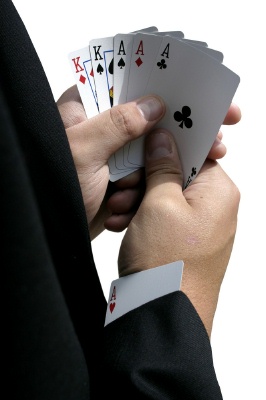|
|

Full House – A five card poker hand consisting of a pair of one rank and three of a kind of another rank.
A full house is a completed five card poker hand containing three of a kind plus a pair. It is also frequently referred to as a “full
boat,” or simply a “boat.” Its rank is determined by the three of a kind it contains. For example, Q-Q-Q-2-2 would be read as “queens
full of deuces,” and would be ranked higher than J-J-J-A-A (jacks full of aces). When reading a full house, the three of a kind is
always read first, and is always “full of” the pair, regardless of the composition of the full house.
In most poker games, a full house ranks higher than a flush, and lower than four of a kind. This means that it is often a strong hand
to complete or to draw to. Since a full house is a completed five card hand, the earliest it can occur is on the flop, or on fifth
street if you are playing in a stud game. A player may also
complete a full house by drawing to either two pair or three of a kind and
by catching one of the necessary cards to complete it. Occasionally, when you flop two pair, you will make three pair on the turn.
This slightly improves your chances of filling up on the river. Still, it is generally easier to fill up when you are drawing to three
of a kind than it is to fill up drawing to either two or three pairs. In situations where a player has filled, and multiple pairs
exist in their hand, the highest full house that can be constructed is the one that plays.
A full house is a difficult and powerful hand to make, and it wins frequently, but it is not a guaranteed winner. Most often, when a
full house does lose, it will not be to a four of a kind or a straight flush, but to another full house. It is often wise to proceed
with caution. If you hold a small full house, or anything smaller than the nut full house in Omaha, you should be careful about how
much heat you take and apply with it. It is not all that uncommon for multiple players to fill up on the same hand. There are times
when you should refrain from raising, and even times you should
muck your full house if either the bet that you are facing or the risk
that you are beaten are unacceptably high.
Interestingly enough, in certain types of stripped deck games, a flush is actually ranked higher than a full house. One example of
this is a version of stripped deck five card stud, which some casinos call “Mexican Poker,” or “Mexican Pokar.” Actually, this name is
a little misleading. The game is very popular throughout Latin America, where it is simply called “Pokar,” or “Poquer.”
Mexican poker is a stripped deck game, which means that all of the eights nines and tens are removed from the deck. With the addidtion
of the Joker, which can be wild, 41 cards remain to play the game with. For the purposes of straights, the jack is considered
sequential to the seven, since all of the eights nines and tens have been stripped out. For example, K-Q-J-7-6 would be a straight.
The game is five card stud, which means that players must form their hand from the first five cards they receive, making strong hands
very difficult to complete.
It may seem counterintuitive that a flush is ranked higher than a full house in this game, but there is a good reason for it. In the
playing environment of a stripped deck, five card stud game, a flush is statistically more difficult to complete than a full house.
This is in contrast to a Seven Card Stud, or a flop game like Hold’em or Omaha where a full house is less likely occurrence than a
flush. Given this, it makes sense that hand rankings are held in reverse order of how likely each is to occur naturally. It is the
fairest way to rank hands, and it provides the game with the proper competitive balance.
Usage: Filled Up, Full On The Flop, Mucked A Full House
Previous Poker Term: Freeze-Out
Next Poker Term: Gutshot Straight |
|









